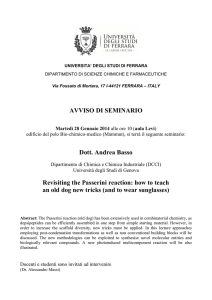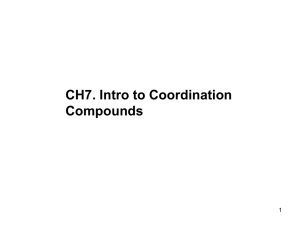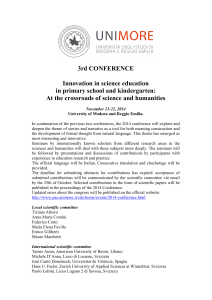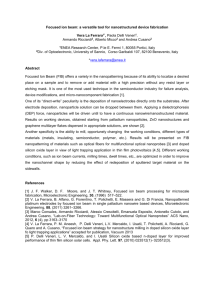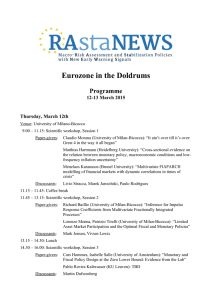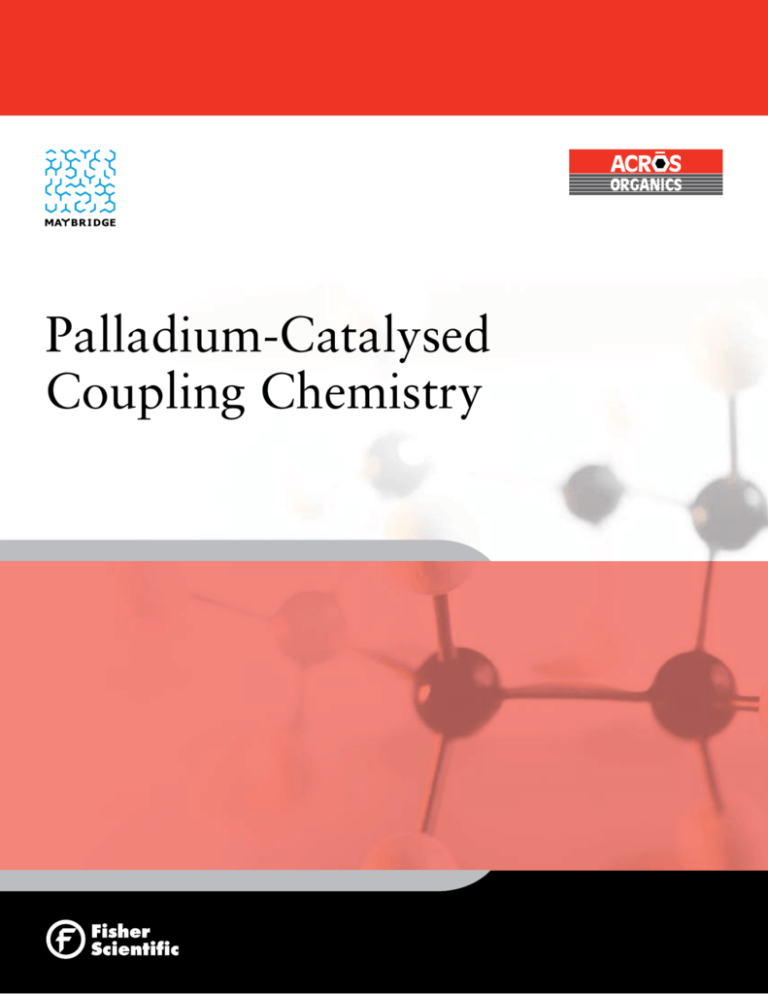
Palladium-Catalysed
Coupling Chemistry
Palladium-Catalysed Coupling Chemistry
Palladium catalysis has gained widespread use in industrial and academic synthetic chemistry laboratories as a powerful methodology for
the formation of C-C and C-Heteroatom bonds.
R
X + R'
M
Pd(0)
R
R'
R = usually sp2 hybridised carbon
X = usually I, Br, Cl or OTf
The nature of R' and M are dependant upon
the specific coupling being performed
SUZUKI-MIYAURA
STILLE
R
Several coupling reactions have been
developed with different substrates:
1. SUZUKI-MIYAURA
2. STILLE
3. NEGISHI
4. KUMADA
5. HIYAMA
6. SONOGASHIRA
7. HECK
8. BUCHWALD-HARTWIG
9. CYANATION
10. CARBONYLATION
R
NEGISHI
R
OR'
R B
OR'
KUMADA
RSnR' 3
R
RZnX
RMgX
HIYAMA
R
RSiR'3
X
+ Pd(0)
X= I, Br, Cl
OTf
SONOGASHIRA
RC
R
HN
CH
R
CH2
R
R
HECK
R
Zn(CN) 2
CO/
Nucleophile
R
N
CN
O
Nu
CYANATION
CARBONYLATION
2
R
BUCHWALD-HARTWIG
Understanding the catalytic cycle
Most palladium catalysed reactions are
believed to follow a similar catalytic cycle.
Oxidative addition
The catalytic species can be formed in situ
using a palladium source, such as Pd2(dba)3
or Pd(OAc)2 and the necessary ligand, or
introduced as a preformed catalyst such as
Pd(PPh3)4 or Pd(PtBu3)2.
Favoured by:
R = electron poor aromatic - reduces
bond dissociation energy for R-X.
Pd catalysts with strong σ-donating ligands
Order od reactivity of X usually l > Br ~ OTf >> Cl
R
Careful choice of ligand can facilitate two
steps of the catalytic cycle. The use of strong
σ-donating ligands, such as trialkylphosphines,
increases electron density around the metal,
accelerating the oxidative addition of
the catalyst to the substrate. This is most
commonly believed to be the rate determining
step. Choice of ligand also determines the
mechanism by which oxidative addition
occurs.1 The elimination step is accelerated
by the use of bulky ligands, in particular
phosphine ligands exhibiting a large cone
angle (also known as Tolman angle).2
X
R
L
Pd
L
L
Oxidative addition
R’
M
Transmetallation
M
X
R
R’
L
X
R- R’
Reductive
elimination
Pd
Pd
R
L
L
Rearrangement
L
Pd
L
R’
Reductive elimination
Transmetallation
Favoured by:
Coupling partners with opposite electronic properties
Presence of bulky ligands to desstabilise rearranged complex
Favoured by:
R’=electron rich group.
Lack of steric hindrance on R and R’
Ligand
Cone Angle (deg)
Cat. No.
dppm
121
29361
dppe
125
14791
dppp
127
31005
dcpe
142
36385
PPh3
145
14042
P(c-hex)3
170
42161
P( Bu)3
182
36089
P(C6F5)3
184
31316
P(2,4,6-Me3C6H2)3
212
32113
t
3
Phosphine ligands have recently been replaced
in a number of palladium cata­ly­sed reactions
with N-heterocyclic carbenes (NHCs).3
Cl
N+
OH
B
+
N
Cl-
OH
Pd 2 (dba) 3 , C s 2 CO 3 , dioxane
13036
These ligands offer similar electronic properties
to phosphines, being strongly σ-donating and
weakly π-acidic. NHCs can offer very high
catalytic activity combined with stability
and longevity in comparison with phosphine
ligands. The carbene is air sensitive but can be
generated in situ to aid operational simplicity.
R
ClN+
N
base
R
R
-HCl
N
N
R
N
Pd(OAc)2
base
N
R
N-Heterocyclic carbene
We offer a range of commonly used NHC
precursors for use in cross coupling reactions.
N+
+
N
Cl-
Cl-
37831
35619
N
N+
-
B
F
F
B-
F
F
35620
38242
References
1. Galardon,E.; Ramdeehul, S.; Brown, J.M.; Cowley, A.; Hii, K.K.; Jutand, A.; Angew.Chem, Int. Ed. 2002 41, 1760-1763
2. Tolman, C. A. Chem. Rev., 1977, 77, 313–348
3. For a review see: Hillier, A.C.; Grasa, G. A.; Viciu, M.S.; Lee, H. M.; Yang, C; Nolan, S. P. J. Organomet. Chem. 2002, 69-82
4
N
F
F
F
N
N
N+
R
R
..
F
Pd
N
N
R
Palladium Catalysed Reactions
1) The Suzuki-Miyaura coupling
R
X +
R'
B(OR)2
Pd(0)
Base
R
R'
The Suzuki coupling reaction involves the
cross coupling of organohalides (and their
equivalents) with organoboron reagents. The
organoboron reagent typically comes in the
form of a boronic acid or ester, of which >300
structurally diverse examples are stocked under
the Acros Organics and Maybridge brands,
and requires activation by base or fluoride to
enable it to undergo transmetallation.
HO
N
O
B
S
HO
O
CC05839
B
B
OH
OH
N
N
CC07412
34467
O
B
O
HO
B
OH
N
O
O
13036
MO08404
The reaction is highly tolerant of many
different functional groups, and boron
containing by-products are easily removed
by a simple alkali work-up. Although most
commonly used to form aryl-aryl bonds
the Suzuki reaction is just as effective for
the synthesis of highly substituted styrene
products.4
O
O
I
MeO
B
Pd(dppf)Cl2.DCM
+
KSAc, DMF
N
Br
O
O
O
O
N
O
O
MeO
Br
MO08253
5
Suzuki chemistry is well known to be accelerated
by the use of microwaves to heat the reaction.5
O
O
OH
NH +
HO
N
B
Na2CO3, Toluene,
150oC, 15 mins
N
Cl
Pd(dppb)Cl2
HN
N
N
MW
35903
MO08305
It can also be used to perform aromatic
alkylations.6 C-H insertion negates the necessity
to begin with an aryl halide, improving the atom
efficiency of the process.
O
OH
Other organoboron species such as trifluoro­
borate salts can also be used in this reaction.7
+
HO
B
OH
O
Pd(OAc)2, KH2PO4
OH
Ag2CO3, Benzoquinone
t
BuOH, 100oC
34467
30926
2) The Stille coupling
R
X +
R'
SnR''3
Pd(0)
The Stille reaction is an extremely versatile
alternative to the Suzuki reaction. It
replaces the organoboron reagents with
organostannanes. As the tin bears four organic
functional groups, understanding the rates of
transmetallation of each group is important.
Relative rate of transmetallation:
Alkynyl > vinyl > aryl > allyl ~ benzyl >> alkyl
The Stille coupling is particularly popular as
organostannanes are readily prepared, purified
and stored. The reaction also has the advantage
that it is run under neutral conditions making
it even more tolerant of different functional
groups than the Suzuki reaction.
R
R'
+
N
SnBu3
Br
N
OEt
+
N
MeCN, 80oC
35000
34717
Cl
Pd2(dba)3, P(2-Fur)3
Pd2(dba)3, P(2-Fur)3
SnBu3
Cl
MeO
SnBu3
+
N
DMF, 75-80oC
37771
11371
N
Cl
N
O
MeO
Pd(PtBu
3)2
CsF, dioxane
60-100oC
Cl
37023
References
4. Jung, D; Shimogawa, H.; Kwon, Y.; Mao, Q.; Sato, S.-I. Kamisuki, S.; Kigoshi, H.; Uesugi, M. J. Am. Chem. Soc. 2009, 131, 4774-4782.
5. van Niel, M. B.; Wilson, K.; Adkins, C. H.; Atack, J. R.; Castro, J. L.; Clarke, D. E.; Fletcher, S.; Gerhard, U.; Mackey, M. M.; Malpas, S.; Maubach,
K.; Newman, R.; O’Connor, D.; Pillai, G. V.; Simpson, P. B.; Thomas, S. R.; MacLoed, A. M. J. Med. Chem. 2005, 48, 6004-6011.
6. Giri, R.; Maugel, N; Li, J.J; Wang, D.-H.; Breazzano, S. P.; Saunders, L. B.; Yu J.-O. J. Am. Chem. Soc. 2007, 129, 3510-3511.
7. Molander, G.A.; Canturk, B. Angew. Chem. Int. Ed. 2009; 48; 9240-9261
6
It can be used to synthesise a wide range of
compounds including styrenes,8 aromatic
ketones9 and biaryl derivatives.10
The Stille-Kelly coupling
The Stille-Kelly coupling is a palladium catalysed intramolecular cross coupling using distannanes such as hexabutyl­distannane or
hexamethyldistannane.
I
N
PdCl2(PPh3)2
O
I
The intermediate mono-halide mono-stannane
cyclises under the reaction conditions to yield
the desired product.11
Me3Sn-SnMe3
Xylene, reflux
N
O
3) The Negishi coupling
R
X +
R'
ZnX
Pd(0)
R
R'
The Negishi coupling utilises organo-zinc
reagents as starting materials to cross couple
with organohalides and equivalents.
The method is compatible with a good range
of functional groups on the organohalide
including ketones, esters, amines and nitriles.
The organo-zinc reagent can be prepared
in situ by a variety of methodologies, such
as transmetallation of the corresponding
organo-lithium or Grignard reagent,12 or via
oxidative addition of activated Zn(0) to an
organohalide.13
N
H
15195
i
PrMgCl.LiCl
THF
O
I
1) TMP.MgCl.LiCl
N 2) ZnCl2
32503
N
ZnCl
24964
N
OEt
Pd2(dba)3
P(2-fur)3
O
OEt
References
8. Nunez, A.; Abarca, B,; Cuadro, A. M.; Alvarez-Builla, J.; Vaquero, J. J. J. Org. Chem. 2009, 74, 4166-4176.
9. Z
heng, G. Z.; Mao, Y.; Lee, C.-H.; Pratt, J. K.; Koenig, J. R.; Perner, R. J.; Cowart, M. D.; Gfesser, G. A.; McGaraughty, S.; Chu, K. L.; Zhu,
C; Yu, H.; Kohlhaas, K.; Alexander, K.M.; Wismer, C.T.; Mikusa, J.; Jarvis, M. F.; Kowaluk E.A.; Stewart, A. O. Bioorg. & Med. Chem. Lett.
2003, 18, 3041-3044.
10. Littke, A. F.; Schwartz, L.; Fu, G. C. J. Am. Chem. Soc. 2002, 124, 6343-6348.
11. Yue, W. S.; Li, J. J. Org.Lett. 2002, 13, 2201-2204.
12. Krasovskiy, A.; Krasovskaya, V.; Knochel, P. Angew. Chem. Int. Ed. 2006, 45, 2958-2961.
13. Prasad, A. S. B.; Stevenson, T. M.; Citineni, J. R.; Nyzam, V.; Knochel, P. Tetrahedron 1997, 53, 7237-7254
7
4) The Kumada coupling
R
X +
R'
MgX
Pd(0)
R
The cross coupling of organohalides with
Grignard reagents is known as the Kumada
coupling. Although it suffers from a limited
tolerance of different functional groups, the
higher reactivity and basicity of the Grignard
reagent allows viable reactions to take place
under mild conditions.14
R'
O
O
MgCl
Pd(dba)2, dppf
+ MeO
MeO
o
THF, -40 C
N
25258
N
Cl
RF04027
5) The Hiyama coupling
R
X +
R'
SiR''3
Pd(0)
Base
Organosilanes can also be coupled with
organohalides (or their equivalents) using
palladium catalysts. As with the Suzuki reaction
the transmetallation will not occur without
activation by base or fluoride.15
The use of a silanol as the organosilane is one
recent method that has managed to negate
the requirement for the reaction to contain
fluoride as an activator.16 This has helped
to enlarge the substrate scope available to
organic chemists.
R
R'
MeO
MeO
+
MeO
OMe
Si
MeO
TBAF, Dioxane
80oC
Br
10663
Pd(OAc)2
DABCO
37064
References
14. Bonnet, V.; Mongin, F.; Trecourt, F.; Queguiner, G.; Knochel. P Tetrahedron 2002, 4429-4438.
15. Li, J.-H.; Deng, W.-J.; Liu, Y.-X. Synthesis 2005, 3039-3044.
16. For a recent review on silanols in the Hiyama coupling see: Denmark, S. E.; Regens, C. S. Acc. Chem. Res. 2008, 41, 1486-1499.
8
6) The Sonogashira coupling
R
X
+
R'
Pd(0)
Cu(I), Base
R
R'
The Sonogashira reaction offers an extremely useful route into aryl- and alkenyl-alkynes. The alkyne moiety is usually introduced via its
copper salt. This is generated in situ from a Cu(I) salt, such as CuI or CuCN, and a terminal alkyne in the presence of an amine base.17
In this case, the TMS protecting group can
be removed following the reaction to give
the terminal alkyne product. This can be
further functionalised, possibly via a second
Sonogashira coupling.
O
O
+
Pd(PPh3)2Cl2
CuI, Et3N, THF
Br
Si
20357
10667
Recent improvements in this reaction have
led to the development of copper and amine
free couplings.18
Si
MeO
MeO
Pd(PPh3)2Cl2
+
TBAF
Br
15246
10663
Other uses for this reaction involve the
synthesis of intermediates that continue
to react under the conditions to give more
interesting products.19
+
N
Br
N
Pd(PPh3)2Cl2, CuI
N
DBU, DMA
N
CC04010
N
N
References
17. Thorand, S.; Krause, N. J. Org. Chem. 1998, 63, 8551-8553.
18. Liang, Y.; Xie, Y.-X.; Li, J.-H. J. Org. Chem. 2006, 71, 379-380.
19. Liu, Y.; Song, Z.; Yan, B. Org. Lett. 2007, 9, 409-412.
9
7) The Heck reaction
R
X
+
R'
Pd(0)
R
R'
The Heck reaction follows a slightly different
pathway to other palladium catalysed couplings.
For intermolecular reactions with monosubstituted olefins, the olefin insertion step
is usually directed by steric hindrance. This
intermediate then undergoes β-hydride elimination under thermodynamically controlled
conditions, leading to preferential formation
of the E product.
R
X
R
L
Pd L
Pd L
X
R’
HX
CH2
Base
H
L
Pd L
syn-olefin insertion
-Hybride elimination
R’
L
X
R
Pd
X
R
10
L
Oxidative addition
R’
L
8) The Buchwald-Hartwig coupling
R
X +
R''
N
H
R'
Pd(0)
Base
R''
N
R'
R
Palladium catalysis has also been expanded to the formation of C-N bonds. In 1995 Buchwald and Hartwig independently reported the
palladium catalysed coupling of aryl halides with amine nucleophiles in the presence of stoichiometric amounts of base.20
The coupling of aryl chlorides with amine
nucleophiles, including anilines and ammo­nia
surrogates, has been reported in high yields
using an NHC ligand.21
Pd2(dba)3
Ligand
H
N
Cl
+
N
t
KO Bu, dioxane
N
N
12627
11002
NH
Cl
Pd2(dba)3
Ligand
+
KOtBu, dioxane
N
36859
29407
Ligand:
N+
N
Cl37831
Hartwig has reported that the use of a
Josiphos based catalyst can facilitate the direct
coupling of ammonia with aryl bromides,
giving predominantly the monoarylamine.22
Br
+
SB01220
NH3
NH2
Pd(Josiphos)Cl2
DME, NaOtBu, 80oC
Josiphos:
PtBu2
Fe
PCy2
References
20. a ) Guram, A. S.; Rennels, R. A.; Buchwald, S. L. Angew. Chem. Int. Ed. 1995, 34, 1348-1350. b) Louie, J.; Hartwig, J. F. Tetrahedron Lett.
1995, 36, 3609-3612.
21. Hillier, A.C.; Grasa, G. A.; Viciu, M.S.; Lee, H. M.; Yang, C; Nolan, S. P. J. Organomet. Chem. 2002, 69-82
22. Shen, Q.; Hartwig, J. J. Am. Chem. Soc. 2006, 128, 10028-10029.
11
9) Palladium catalysed cyanation
The palladium catalysed cyanation of
aromatic halides offers a convenient alternative to the Rosemund-Von Braun reaction,
which often employs harsh reaction conditions and can have a labour intensive workup. As the cyanide nucleophile is a strong
σ-donor and can poison the catalyst, it is
necessary to keep its concentration low during the reaction. To achieve this Zn(CN)2 is
often employed as the cyanide source as its
solubility in DMF (a common solvent for this
reaction) is limited.23
F
Pd2(dba)3, dppf
N
Cl
N
F
N
Zn(CN)2, Zn powder
DMA, MW, 100oC
N
N
42981
An alternative, non-toxic, source of cyanide
has also been reported. K4[Fe(CN)6] can be
used in combination with palladium catalysts
to synthesise aryl nitriles from their corresponding halides.24
Br
N
Pd(OAc)2, dppf
K4[Fe(CN)6]
Na2CO3, DMA, 140oC
S
S
14780
This work was later extended to enable the
reaction to take place without the need for the
phosphine ligand.25
Br
O
Pd(OAc)2, K4[Fe(CN)6]
Na2CO3, DMA, 140oC
OMe
O
OMe
41407
References
23. Zn(CN)2 has a solubility of 1.8 x 10-4 g/mL in DMF at 80oC.
24. Schareina, T.; Zapf, A.; Beller, M. Chem. Comm. 2004, 1388-1389
25. Weissman, S. A.; Zewge, D.; Chen, C. J. Org. Chem. 2005, 70, 1508-1510
12
N
10) Palladium catalysed carbonylation
R
X
O
Pd(0)
R
CO, "Nu", Base
Nu
Nu = R'O, R'R''N, H
As with most palladium mediated C-C bond
forming reactions palladium catalysed carbonylation is compatible with a range of
functional groups. This gives it significant
advantages over standard organolithium and
Grignard chemistry for the synthesis of aryl
aldehydes, acids, esters and amides.
Pd(PhCN)2Cl2 (0.1 mol%)
dppf (0.6 mol%), CO (25 bar)
N
Cl
OBu
N
Et3N (1.2 eq), n-BuOH, 130oC
O
11001
Esters and amides are synthesised by car­
bonylation in the presence of the required
alcohol26 or amine nucleophile.27
N
H
+
10706
The use of triethylsilane as the nucleophile
gives the corresponding aldehyde as the
product.28
O
Pd(PhCN)2Cl2 (1 mol%)
dppf (3 mol%), CO (25 bar)
Br
N
H
Et3N (1.5 eq), toluene, 130oC
N
N
H
14718
Br
O
N
H
[PdCl2dppp] (2.5 mol%)
CO (3 bar), HSiEt3 (2 eq)
Na2CO3 (1 eq), DMF, 90oC
O
H
O
17157
N
H
References
26. Beller, M.; Mägerlein, W.; Indolese, A. F.; Fischer C. Synthesis, 2001, 1098-1110
27. Kumar K.; Zapf, A.; Michalik, D; Tillack, A.; Heinrich, T.; Bottcher, H.; Arlt, M.; Beller, M. Org. Lett., 2004, 6, 7-10.
28. Ashfield, L.; Barnard, C. F. J.; Org. Process Res. Dev., 2007, 11, 39-43
13
Monodentate Ligands
Bidentate Ligands
General ligands
General ligands
Cat. No.
Ligand Name
CAS No
Cat. No. Ligand Name
CAS No
14042
29480
42232
32113
42161, 38683,
42842, 42783
31733
13934
38338
Triphenylphosphine
Tri-(2-furyl)phosphine
Tri-o-tolylphosphine
Trimesitylphosphine
603-35-0
5518-52-5
6163-58-2
23897-15-6
Tricyclohexylphosphine
2622-14-2
Triisopropylphosphine
Tri-n-butylphosphine
Di-tert-butylmethylphosphine
6476-36-4
998-40-3
6002-40-0
36089, 36694
Tri-tert-butylphosphine
13716-12-6
29361
14791
36385
31005
38112
29646
32085
38337
34801
36387
42971
36375
2071-20-7
1663-45-2
23743-26-2
6737-42-4
103099-52-1
7688-25-7
27721-02-4
166330-10-5
12150-46-8
97239-80-0
84680-95-5
13991-08-7
Buchwald type ligands
Cat. No. Ligand Name
38972
38714
35621
35622
35623
38009
38008
38007
38006
42983
42984
2-(Dicyclohexylphosphino)-2’isopropylbiphenyl
2-(Dicyclohexylphosphino)-2’,4’,6’triisopropylbiphenyl
2-(Di-tert-butylphosphino)biphenyl
2-(Dicyclohexylphosphino)biphenyl
2-Dicyclohexylphosphino-2’-(N,Ndimethylamino)biphenyl
2-Diphenylphosphino-2’-(N,Ndimethylamino)biphenyl
2-(Dicyclohexylphosphino)-2’-methylbiphenyl
2-(Di-tert-butylphosphino)-2’-methylbiphenyl
2-Di-tert-butylphosphino-2’-(N,Ndimethylamino)biphenyl
2-Dicyclohexylphosphino-2’,6’-diisopropoxy1,1’-biphenyl
2-Di-tert-butylphosphino-2’,4’,6’triisopropylbiphenyl
37806
CAS No
251320-85-1
564483-18-7
35619
37831
37832
35620
38242
37833
37834
14
1,3-Bis(2,4,6-trimethylphenyl)imidazolium
chloride
1,3-Bis(2,6-diisopropylphenyl)imidazolium
chloride
1,3-Bis(adamant-1-yl)imidazolium chloride
1,3-Bis(2,4,6-trimethylphenyl)-4,5dihydroimidazolium tetrafluoroborate
1,3-Bis(2,6-diisopropylphenyl)
imidazolidinium tetrafluoroborate
1,3-Bis(2,4,6-trimethylphenyl)
imidazolidinium chloride
1,3-Bis(2,6-diisopropylphenyl)
imidazolidinium chloride
161265-03-8
BINAP ligands
Cat. No. Ligand Name
224311-51-7
247940-06-3
38235
213697-53-1
38234
240417-00-9
26554
251320-86-2
255837-19-5
26553
224311-49-3
39223
787618-22-8
39222
564483-19-8
36864
(S)-(-)-2,2’-Bis(di-p-tolylphosphino)-1,1’binaphthyl
(R)-(+)-2,2’-Bis(di-p-tolylphosphino)-1,1’binaphthyl
(S)-(-)-2,2’-Bis(diphenylphosphino)-1,1’binaphthyl
(R)-(+)-2,2’-Bis(diphenylphosphino)-1,1’binaphthyl
rac-2,2’-Bis(di-p-tolylphosphino)-1,1’binaphthyl
rac-2,2’-Bis(di(3,5-dimethylphenyl)
phosphino)-1,1’-binaphthyl
(±)-2,2’-Bis(diphenylphosphino)-1,1’binaphthyl
CAS No
100165-88-6
99646-28-3
76189-56-5
76189-55-4
153305-67-0
145416-77-9
98327-87-8
Josiphos ligands
NHC ligands
Cat. No. Ligand Name
Bis(diphenylphosphino)methane
1,2-Bis(diphenylphosphino)ethane
1,2-Bis(dicyclohexylphosphino)ethane
1,3-Bis(diphenylphosphino)propane
1,3-Bis(dicyclohexylphosphino)propane
1,4-Bis(diphenylphosphino)butane
1,5-Bis(diphenylphosphino)pentane
Bis(2-diphenylphosphinophenyl)ether
1,1’-Bis(diphenylphosphino)ferrocene
1,1’-Bis(diisopropylphosphino)ferrocene
1,1’-Bis(di-tert-butylphosphino)ferrocene
1,2-Bis(diphenylphosphino)benzene
9,9-Dimethyl-4,5-bis(diphenylphosphino)
xanthene
CAS No
141556-45-8
Cat. No. Ligand Name
37075
250285-32-6
131042-78-9
245679-18-9
282109-83-5
173035-10-4
258278-25-0
37070
37069
37068
37067
(R)-(-)-1-[(S)-2-Di-t-butylphosphino)
ferrocenyl]ethyldi-(4-trifluoromethylphenyl)
phosphine
(R)-(-)-1-[(S)-2-Diphenylphosphino)
ferrocenyl]ethylbis(3,5-dimethylphenyl)
phosphine
(R)-(-)-1-[(S)-2-Dicyclohexylphosphino)
ferrocenyl]ethyldicyclohexylphosphine
(R)-(-)-1-[(S)-2-Diphenylphosphine)ferrocenyl]
ethyldi-tert-butylphosphine
(R)-(-)-1-[(S)-2-Diphenylphosphino)
ferrocenyl]ethyldicyclohexylphosphine
CAS No
246231-79-8
184095-69-0
167416-28-6
155830-69-6
155806-35-2
Palladium catalysts and precursors
Catalyst precursors
Cat. No. Catalyst Precursor Name
CAS No
20683
20945
20790
29197
19518
19519
19520,
36967
31702
Allylpalladium chloride dimer
Bis(acetonitrile)palladium(II) chloride
Bis(benzonitrile)palladium(II) chloride
Bis(dibenzylideneacetone)palladium
Palladium(II) acetate
Palladium(II) bromide
12012-95-2
14592-56-4
14220-64-5
32005-36-0
3375-31-3
13444-94-5
Palladium(II) chloride
7647-10-1
Palladium(II) trifluoroacetate
Tetrakis(acetonitrile)palladium(II)
tetrafluoroborate
Tris(dibenzylideneacetone)dipalladium(0)
Tris(dibenzylideneacetone)dipalladiumchloroform adduct
42196-31-6
36352
31877
36934
21797-13-7
51364-51-3
52522-40-4
Catalysts
Cat. No. Catalyst Name
38403
34868
36351
37797
20927
19732,
29925
36350
21299
37796
39589
20238
36971
[1,2-Bis(diphenylphosphino)ethane]
dichloropalladium(II)
1,1’-Bis(diphenylphosphino)ferrocenepalladium(II)dichloride dichloromethane
adduct
Bis(tricyclohexylphosphine)palladium(0)
Bis(triethylphosphine)palladium(II) chloride
Bis(triphenylphosphine)palladium(II) acetate
CAS No
19978-61-1
95464-05-4
33309-88-5
28425-04-9
14588-08-0
Bis(triphenylphosphine)palladium(II) chloride 13965-03-2
Bis(tri-t-butylphosphine)palladium(0)
Bis[1,2-bis(diphenylphosphino)ethane]
palladium(0)
Bis[tri(o-tolyl)phosphine]palladium(II)
chloride
Dichlorobis(tricyclohexylphosphine)
palladium(II)
Tetrakis(triphenylphosphine)palladium(0)
trans-Benzyl(chloro)bis(triphenylphosphine)
palladium(II)
53199-31-8
31277-98-2
40691-33-6
29934-17-6
14221-01-3
22784-59-4
15
GLOBAL LOCATIONS
AMERICAS
Japan
Fisher Scientific Canada
112 Colonnade Road
Ottawa, Ontario
Post Code: K2E 7L6
Toll-Free Number: 800-234-7437
Fax: 800-463-2996
www.fishersci.ca
Fisher Scientific Japan
Thermo Fisher Scientific K.K.
C-2F, 3-9 Moriya-cho
Kanawaga-ku, Yokohama
221-0022 Japan
Tel: 81 45 450 6310
Fax: 81 45 450 6316
support@fishersci.co.jp
www.fishersci.co.jp
Latin America
Korea
Canada
Fisher Scientific Global Export, Latin America
3970 Johns Creek Court
Suite 500
Suwanee, GA
Post Code: 30024
Toll-Free Number: 770-871-4725
Fax: 770-871-4726
www.fishersci.com
United States
Fisher HealthCare
9999 Veterans Memorial Drive
Houston, TX
Post Code: 77038
Toll-Free Number: 800-640-0640
Fax: 800-290-0290
www.fisherhealthcare.com
Fisher Scientific
2000 Park Lane Drive
Pittsburgh, PA
Post Code: 15275
Toll-Free Number: 800-766-7000
Fax: 800-926-1166
www.fishersci.com
ASIA
China
Fisher Scientific China
Toll-Free Number: 400 881 5117
sales.china@thermofisher.com
www.fishersci.com.cn
Shanghai Corporate Office
6/F Long Life Mansion
No. 1566 Yan An West Rd.
Shanghai, China
Post Code: 200052
Tel: (8621) 5258 1100
Fax: (8621) 5258 0119
Beijing Office
Units 702-715, 7th Floor
Tower West, Yonghe Plaza
No. 28 Andingmen East Street
Beijing, China
Post Code: 100007
Tel: (8610) 8419 3588
Fax: (8610) 8419 3580
Guangzhou Office
Room 2405-2406, JianLiBao Mansion
No. 410-412 Middle DongFeng Rd.
Guangzhou, China
Post Code: 510030
Tel: (8620) 8314 5288
Fax: (8620) 3877 1941
India
Fisher Scientific India
101A-101B, Godrej Coliseum,
Somaiya Hospital Road,
Off Eastern Express Highway,
Sion East, Mumbai 400 022
Customer Service Toll Free: 1 800 209 7001
Fax: 022 6680 3001 or 3002
qfc.customercare@thermofisher.com
www.fishersci.in
Fisher Scientific Korea
Sambu Bldg. 13F
676 Yeoksam-dong,
Kangnam-Gu
Seoul 135-979, Korea
Dir (02) 527-0300
Customer Service Center: (02) 527-0300
Fax: (02) 527-0311
sales@fishersci.co.kr
www.acros.co.kr
Malaysia
Fisher Scientific Malaysia Sdn Bhd
No. 3 Jalan Sepadu 25/123
Taman Perindustrian Axis Seksyen 25
40400 Shah Alam
Selangor Darul Ehsan Malaysia
Technical Service Hotline: 1-300-88-7868
Tel: (603) 51218888
Fax: (603) 51218899
Marketing.FSM@thermofisher.com
www.fishersci.com.my
Singapore
Fisher Scientific Singapore
Fisher Scientific Pte Ltd.
8 Pandan Crescent
LL4, #05-05 UE Tech Park
Singapore 128464
Tel: (65) 6873 6006
Fax: (65) 6873 5005
enquiry.sg@thermofisher.com
www.fishersci.com.sg
EUROPE
Austria
Fisher Scientific (Austria) GmbH
Rudolf von Alt-Platz 1
A-1030 Wien
Phone: 0800 20 88 40
Fax: 0800 20 66 90
info.austria@thermofisher.com
www.at.fishersci.com
Belgium
Fisher Scientific
BP 567
B-7500 Tournai 1
Tel: 056 260 260
Fax: 056 260 270
be.fisher@thermofisher.com
www.be.fishersci.com
Czech Republic
Fisher Scientific, spol. s r.o.
Kosmonautu 324
Pardubice
CZ-530 09
Tel: 466 798 230
Fax: 466 435 008
info.cz@thermofisher.com
www.thermofisher.cz
Denmark
Fisher Scientific Biotech Line A/S
Industrivej 3
Postboks 60
DK-3550 Slangerup
Tel: +45 70 27 99 20
Fax: +45 70 27 99 29
kundeservice@thermofisher.com
www.fishersci.dk
Finland
Fisher Scientific Oy
Ratastie 2
FI-01620 Vantaa
Tel: +358 802 76 237
Fax: +358 802 76 235
fisher.fi@thermofisher.com
www.fishersci.fi
France
Fisher Scientific
Parc d’Innovation BP 50111
67403 Illkirch Cedex
Tel: 03 88 67 53 20
Fax: 03 88 67 11 68
fr.commande@thermofisher.com
www.fr.fishersci.com
Germany
Spain
Fisher Scientific
C/ Luis I, 9
28031 MADRID
Tfno: 91 380 67 10
Fax: 91 380 85 02
es.fisher@thermofisher.com
www.es.fishersci.com
Sweden
Fisher Scientific
Box 9193
400 94 Göteborg
Tel: +46 31 - 68 94 30
Fax: +46 31 - 68 07 17
gtf.info@thermofisher.com
www.fishersci.se
Switzerland
Fisher Scientific
Wilstrasse 57 - Postfach 1006
5610 Wohlen
Tel: 056 618 41 11
Fax: 056 618 41 41
info.ch@thermofisher.com
www.ch.fishersci.com
United Kingdom
Fisher Scientific GmbH
Im Heiligen Feld 17
D-58239 Schwerte
Phone: 0800 3 47 43 70
Fax: 0800 3 47 43 71
info.germany@thermofisher.com
www.de.fishersci.com
Fisher Scientific UK
Bishop Meadow Road
Loughborough
Leicestershire LE11 5RG
Tel: +44 (0)1509 231166
Fax: +44 (0)1509 231893
info@fisher.co.uk
www.fisher.co.uk
Ireland
Rest of Europe
Fisher Scientific Ireland
Suite 3 Plaza 212
Blanchardstown Corporate
Park 2
Ballycoolin
Dublin 15
Tel: +353 01 885 5854
Fax: +353 01 899 1855
fsie.sales@thermofisher.com
www.ie.fishersci.com
Italy
Fisher Scientific
Tel: 02 953 28 258
Fax: 02 953 27 374
it.fisher@thermofisher.com
www.it.fishersci.com
The Netherlands
Fisher Scientific
Postbus 4
1120 AA Landsmeer
Tel: 020 487 70 00
Fax: 020 487 70 70
nl.info@thermofisher.com
www.nl.fishersci.com
Norway
Fisher Scientific
Frysjaveien 33E
0884 Oslo
Tel: +47 22 95 59 59
Fax: +47 22 95 59 40
fisher.no@thermofisher.com
www.fishersci.no
Portugal
Fisher Scientific
Rua Pedro Álvares Cabral, nº24, 3ºD
Edifício Euro - Infantado
2670-391 Loures
Telefone: +351 21 425 33 50/4
Fax: +351 21 425 33 51
pt.fisher@thermofisher.com
www.pt.fishersci.com
Thermo Fisher Scientific
Geel West Zone 2
Janssen Pharmaceuticalaan 3a
2440 Geel – Belgium
Tel: +32 14 57 52 11
Fax: +32 14 59 26 10
www.acros.com
MIDDLE EAST AND AFRICA
Fisher Scientific Global Export,
Latin America
3970 Johns Creek Court
Suite 500
Suwanee, GA
Post Code: 30024
Toll-Free Number: 770-871-4725
Fax: 770-871-4726
www.fishersci.com
OCEANIA
Australia
Thermo Fisher Scientific Australia Pty Ltd
5 Caribbean Drive
Scoresby, VIC 3179
Tel: +1300 735 292
Fax: +61 3 9763 1169
AUinfo@thermofisher.com
www.thermofisher.com.au
New Zealand
Thermo Fisher Scientific New Zealand Ltd 244
Bush Road,
Albany, Auckland 0632
Tel: 0800 933 966
Fax: +64 9 980 6788
infonz@thermofisher.com
www.thermofisher.co.nz
©2010 Thermo Fisher Scientific Inc.
All rights reserved. All brands and trademarks
are part of Thermo Fisher Scientific Inc. and
its subsidiaries.

